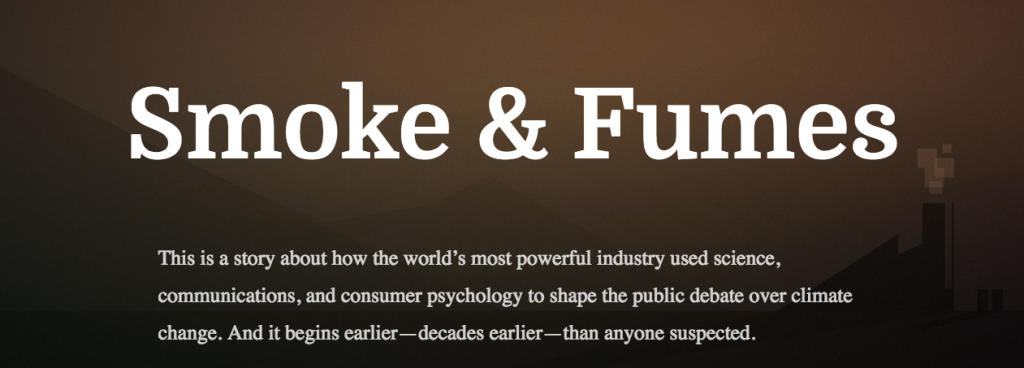
The document trove which we call “Smoke And Fumes” actually began under a different name. Internally, the project was referred to as “What They Knew” for most of its life. This reflected the fact that the research was not about finding the needle in the haystack, or one specific smoking gun, but about exploring the question: what did they know?
The investigation began with a focus on governments, not corporations. For most of the last four centuries, international law has primarily governed the action of nations, so we started there. We looked at statements of government officials and reports issued by and submitted to government agencies. Our original goal was to understand when political leaders of the United States were first on notice of the potentially serious risks of climate change. As many already know, the record of U.S. government knowledge on climate change dates back decades – James Hansen testifying to Congress in 1988; the Charney Report in 1979; the JASON report before that; the Nixon White House memos; President Johnson’s address to Congress in 1965. All demonstrated that the United States government knew more, earlier, than the great majority of nations. But we found something else: we found that the oil industry was involved at every step – and often a step ahead.
The first major clue was in a report called “Carbon Dioxide and Climate: A Scientific Assessment”, often referred to as the Charney Report, owing to the leadership of Jule Charney in its preparation. The Charney Report was a full synthesis of the scientific evidence on climate change for use in projecting and policymaking. The year was 1979. And right there on the Climate Research Board was Dayton H. Clewell, a retired executive and scientist for Mobil Oil Corporation. By this point, and no later, we realized, the oil industry was on clear and irrefutable notice of the risks of climate change. So this, 1979, was our starting point. We worked backward from there. And we realized that there would be a time, before Tobacco, before Exxon Secrets, before the global climate debate, when the industry was more candid about climate change in public—or semi-public—documents. It was those documents we went looking for.
When we looked back a little further, we saw Dayton H. Clewell again. In 1971, he was appointed to the first National Advisory Committee on Oceans and Atmosphere. His first task on the Committee: explore how to limit the damage of future hurricanes in the wake of Hurricane Agnes, the costliest hurricane the US had ever experienced to that point. We also found a report from the oil industry to the Department of the Interior from 1972 – with an entire section on carbon dioxide in the atmosphere. (Though its significance to the story did not become clear until months later.) Clearly, the industry was involved, and not as a sideline player.
Shifting focus to the oil companies meant we had to begin asking the same questions from the beginning: What did they know? When did they know it? What did they do with that information?
We started with known documents and secondary sources to point us in the right direction. The goal was to understand the structure of the industry research apparatus. What did their business require them to know? What sort of expertise could they be expected to have? And could we prove that they had it? –Yes, it turns out, we could. We also wanted to know who the key players were, in science and industry. We followed the money; who was funding the science, and what were they funding?
This research led us to the same names, again and again. The American Petroleum Institute; Humble Oil Production Research Division; Stanford Research Institute; Scripps Institute of Oceanography. We identified large collections of research into smog, atmospheric emissions, carbon dioxide, hurricanes, paleoclimate, and sea level rise, among others.
Eventually, the interconnections between the documents became clear and the through lines emerged. The oil industry organized itself, early and effectively, to deal with the issue of air pollution generally and smog particularly. In Los Angeles, it formed a committee that represented the entire industry of the region, populated by executives from the major companies. The industry formed an early relationship with Stanford Research Institute, an ostensibly independent research laboratory, which the oil industry helped fund, create, and, in its early years, govern.
The industry also sponsored work at the Scripps Institute of Oceanography. Later, Roger Revelle and Hans Suess of Scripps published their famous paper claiming the oceans wouldn’t absorb as much carbon as everyone hoped. Within months, industry scientists responded with their own contradictory study, and acknowledged they were in direct conversation (and disagreement) with Revelle. In 1965, Revelle led a broader committee that reported to the President on the risks of continued carbon pollution. In 1968, the industry received a report from Stanford Research Institute that warned the industry of the same, relying in part on Revelle’s earlier work. That report—both what it said, and how the industry responded—proved an important moment in our story.
Concurrently, the industry collaborated to study hurricanes from the 1940s onward. It developed computer models to better predict when and where hurricanes would form and how they would move. It funded research into sea level changes and paleoclimates, and reconstructed historical sea-state elevations to better explore for oil. So when the first red flags were raised in the climate debate, there was no other industry with as much expertise in the science necessary to understand the causes and consequences of climate change.
In tracing all of these connections it became clear why this information had remained hidden in plain sight for so long. First, scientists weren’t always using modern terms like “global warming”, “Climate change” or even “carbon dioxide” in the earliest decades of the debate. In the 1940s, 50s, 60s, they referred to “climatic change” but not “climate change”. They studied “radiocarbon dilution”, “fossil carbon” and, later, the “Suess effect.” These terms, though closely related to their modern counterparts, would not appear in typical search engine results.
Second, because the story is in the science, much of it is buried in industry proceedings thousands of pages long, speeches at industry gatherings, or scientific publications eight decades old, often hidden behind paywalls. It was also buried in the sheer, overwhelming volume of online data which demanded that we know more or less exactly what and who we were looking for before we could hope to find it. When we did, key resources were sometimes limited to clips that Google Scholar and Google Books permit. This makes accessing the building blocks of this story more difficult, time consuming, and, frankly, expensive. Some resources, like archives where we know more promising documents exist, are completely shut off to nonmembers. In some cases, we had to do our best with abstracts until we could locate a resource in a reachable library.
Third, and finally, this story was difficult to tell because it is exactly that – a story. Indeed, multiple overlapping and interwoven stories. It was never about one document or one study; it is a mosaic of the early efforts of the oil industry coordinating to pursue scientific research for use in business decision making, and to use that science to influence the public and prevent unwanted regulation. That is, however, what makes the prospects for the future so exciting.
We have unearthed hundreds of documents. Some were false positives, and some were false negatives that only made sense after we found other documents that made sense of them. But with each new piece of the puzzle our understanding of where to find the missing pieces, and where they fit, is improving. We are a small team working with limited resources; but as the InsideClimate News stories reflect, we are not alone. Our ambition, beyond spreading the word about the early history of the oil industry, is to spur a wave of investigation that eclipses what was possible when it was just us in our offices.
There are tendrils to this story that haven’t even begun to be explored, and our sincere hope is that others will join us to add more to this complicated, critical mosaic – one tile at a time.

